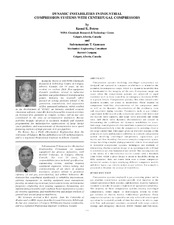| dc.description.abstract | Compression systems involving centrifugal compressors are designed and operated in a manner to eliminate or minimize the potential for compressor surge, which is a dynamic instability that is detrimental to the integrity of the unit. Compressor surge can occur when the compression systems are subjected to rapid transients such as those caused by and emergency shutdown (ESD) or a power failure. Compression systems, like other second-order dynamic systems, are prone to instabilities. These depend on compressor head-flow characteristics of the compressor units as well as the dynamic characteristics of the machinery train and associated piping systems. Parameters such as gas volume capacitance in the recycle path, compressor power train inertia and the recycle valve capacity, anti-surge valve prestroke and stroke time, and check valve dynamic characteristics are crucial in determining the conditions for dynamic instabilities to occur. Anti-surge control protocols also contribute to potential compressor instabilities particularly when the compressor is operating close to the surge control line. This paper gives an overview concept of the principle of static and dynamic stabilities in a simple compression system involving centrifugal compressors, capacitance, gas inertia, and flow throttling. For a more complex compression system design, involving complex piping geometries akin to those employed in industrial compression system, techniques and methods of determining whether a certain design or an operating mode will lead to instabilities are also formulated and solved. This investigation lead to the notion of a dimensionless inertia number with a threshold value below which a given design is prone to instability during an ESD operation. Data are drawn from over a dozen compressor station of various designs employing different compressor models and drive types, e.g., electric motors or gas turbines. An example is presented to illustrate the concept of instabilities. | en |


